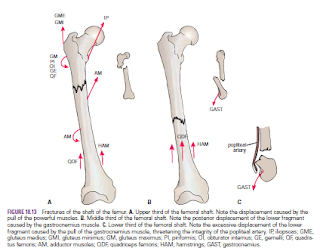Ligaments
of the Gluteal Region
The two important ligaments in the gluteal region are the
sacrotuberous and sacrospinous ligaments. The function of these ligaments is to
stabilize the sacrum and prevent its rotation at the sacroiliac joint by the
weight of the vertebral column.
Sacrotuberous Ligament
The sacrotuberous ligament connects the back of the sacrum
to the ischial tuberosity.
Sacrospinous Ligament
The sacrospinous ligament connects the back of the sacrum to
the spine of the ischium.
Foramina
of the Gluteal Region
The two important foramina in the gluteal region are the greater
sciatic foramen and the lesser sciatic foramen.
Greater Sciatic Foramen
The greater sciatic foramen is formed by the greater sciatic
notch of the hip bone and the sacrotuberous and sacrospinous ligaments. It
provides an exit from the pelvis into the gluteal region.
The following structures exit the foramen:
■■
Piriformis
■■
Sciatic nerve
■■
Posterior cutaneous nerve of the thigh
■■ Superior and inferior gluteal nerves
■■ Superior and inferior gluteal nerves
■■ Nerves
to the obturator internus and quadratus femoris
■■
Pudendal nerve
■■
Superior and inferior gluteal arteries and veins
■■
Internal pudendal artery and vein
Lesser
Sciatic Foramen
The lesser sciatic foramen is formed by the lesser sciatic
notch of the hip bone and the sacrotuberous and sacrospinous ligaments. It
provides an entrance into the perineum from the gluteal region. Its presence
enables nerves and blood vessels that have left the pelvis through the greater
sciatic foramen above the pelvic floor to enter the perineum below the pelvic
floor.
The following structures pass through the foramen
■■
Tendon of obturator internus muscle
■■
Nerve to obturator internus
■■
Pudendal nerve
■■
Internal pudendal artery and vein
Muscles
of the Gluteal Region
The muscles of the gluteal region include the gluteus
maximus, the gluteus medius, the gluteus minimus, the tensor fasciae latae, the
piriformis, the obturator internus, the superior and inferior gemelli, and the
quadratus femoris.
Note the following:
■■ The
gluteus maximus is the largest muscle in the body. It lies superficial in the
gluteal region and is largely responsible for the prominence of the buttock.
■■ The
tensor fasciae latae runs downward and backward to its insertion in the
iliotibial tract and thus assists the gluteus maximus muscle in maintaining the
knee in the extended position.







